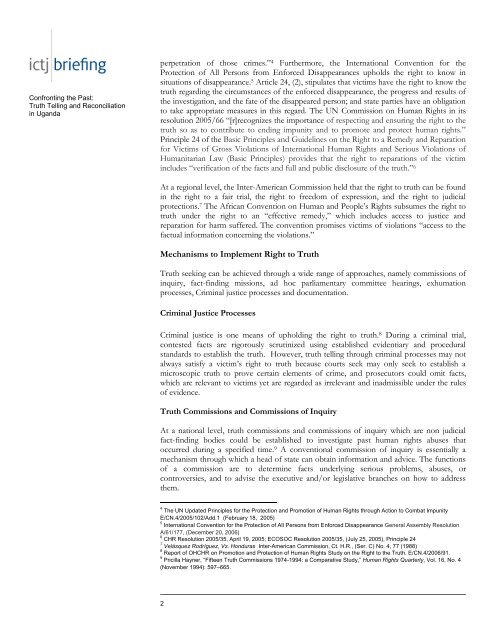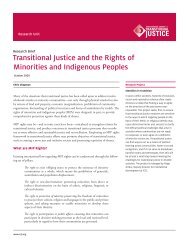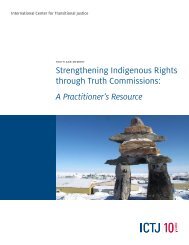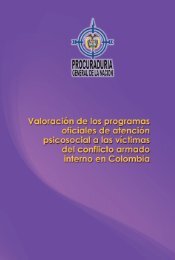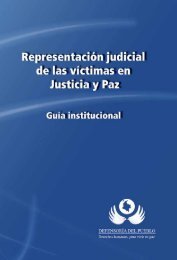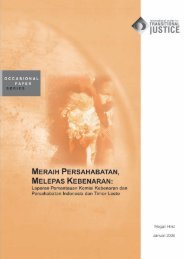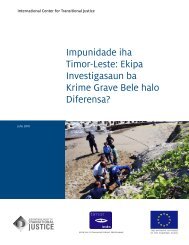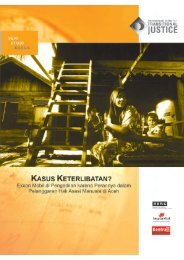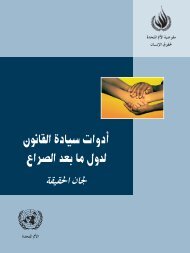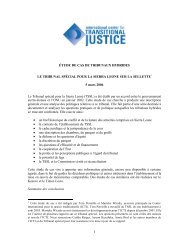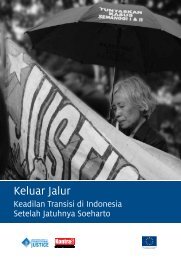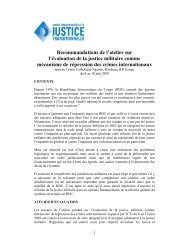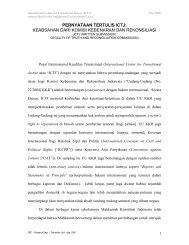Truth Telling and Reconciliation in Uganda - International Center for ...
Truth Telling and Reconciliation in Uganda - International Center for ...
Truth Telling and Reconciliation in Uganda - International Center for ...
You also want an ePaper? Increase the reach of your titles
YUMPU automatically turns print PDFs into web optimized ePapers that Google loves.
Confront<strong>in</strong>g the Past:<strong>Truth</strong> <strong>Tell<strong>in</strong>g</strong> <strong>and</strong> <strong>Reconciliation</strong><strong>in</strong> Ug<strong>and</strong>aperpetration of those crimes.” 4 Furthermore, the <strong>International</strong> Convention <strong>for</strong> theProtection of All Persons from En<strong>for</strong>ced Disappearances upholds the right to know <strong>in</strong>situations of disappearance. 5 Article 24, (2), stipulates that victims have the right to know thetruth regard<strong>in</strong>g the circumstances of the en<strong>for</strong>ced disappearance, the progress <strong>and</strong> results ofthe <strong>in</strong>vestigation, <strong>and</strong> the fate of the disappeared person; <strong>and</strong> state parties have an obligationto take appropriate measures <strong>in</strong> this regard. The UN Commission on Human Rights <strong>in</strong> itsresolution 2005/66 “[r]recognizes the importance of respect<strong>in</strong>g <strong>and</strong> ensur<strong>in</strong>g the right to thetruth so as to contribute to end<strong>in</strong>g impunity <strong>and</strong> to promote <strong>and</strong> protect human rights.”Pr<strong>in</strong>ciple 24 of the Basic Pr<strong>in</strong>ciples <strong>and</strong> Guidel<strong>in</strong>es on the Right to a Remedy <strong>and</strong> Reparation<strong>for</strong> Victims of Gross Violations of <strong>International</strong> Human Rights <strong>and</strong> Serious Violations ofHumanitarian Law (Basic Pr<strong>in</strong>ciples) provides that the right to reparations of the victim<strong>in</strong>cludes “verification of the facts <strong>and</strong> full <strong>and</strong> public disclosure of the truth.” 6At a regional level, the Inter-American Commission held that the right to truth can be found<strong>in</strong> the right to a fair trial, the right to freedom of expression, <strong>and</strong> the right to judicialprotections. 7 The African Convention on Human <strong>and</strong> People’s Rights subsumes the right totruth under the right to an “effective remedy,” which <strong>in</strong>cludes access to justice <strong>and</strong>reparation <strong>for</strong> harm suffered. The convention promises victims of violations “access to thefactual <strong>in</strong><strong>for</strong>mation concern<strong>in</strong>g the violations.”Mechanisms to Implement Right to <strong>Truth</strong><strong>Truth</strong> seek<strong>in</strong>g can be achieved through a wide range of approaches, namely commissions of<strong>in</strong>quiry, fact-f<strong>in</strong>d<strong>in</strong>g missions, ad hoc parliamentary committee hear<strong>in</strong>gs, exhumationprocesses, Crim<strong>in</strong>al justice processes <strong>and</strong> documentation.Crim<strong>in</strong>al Justice ProcessesCrim<strong>in</strong>al justice is one means of uphold<strong>in</strong>g the right to truth. 8 Dur<strong>in</strong>g a crim<strong>in</strong>al trial,contested facts are rigorously scrut<strong>in</strong>ized us<strong>in</strong>g established evidentiary <strong>and</strong> proceduralst<strong>and</strong>ards to establish the truth. However, truth tell<strong>in</strong>g through crim<strong>in</strong>al processes may notalways satisfy a victim’s right to truth because courts seek may only seek to establish amicroscopic truth to prove certa<strong>in</strong> elements of crime, <strong>and</strong> prosecutors could omit facts,which are relevant to victims yet are regarded as irrelevant <strong>and</strong> <strong>in</strong>admissible under the rulesof evidence.<strong>Truth</strong> Commissions <strong>and</strong> Commissions of InquiryAt a national level, truth commissions <strong>and</strong> commissions of <strong>in</strong>quiry which are non judicialfact-f<strong>in</strong>d<strong>in</strong>g bodies could be established to <strong>in</strong>vestigate past human rights abuses thatoccurred dur<strong>in</strong>g a specified time. 9 A conventional commission of <strong>in</strong>quiry is essentially amechanism through which a head of state can obta<strong>in</strong> <strong>in</strong><strong>for</strong>mation <strong>and</strong> advice. The functionsof a commission are to determ<strong>in</strong>e facts underly<strong>in</strong>g serious problems, abuses, orcontroversies, <strong>and</strong> to advise the executive <strong>and</strong>/or legislative branches on how to addressthem.4 The UN Updated Pr<strong>in</strong>ciples <strong>for</strong> the Protection <strong>and</strong> Promotion of Human Rights through Action to Combat ImpunityE/CN.4/2005/102/Add.1 (February 18, 2005)5 <strong>International</strong> Convention <strong>for</strong> the Protection of All Persons from En<strong>for</strong>ced Disappearance General Assembly ResolutionA/61/177, (December 20, 2006)6 CHR Resolution 2005/35, April 19, 2005; ECOSOC Resolution 2005/35, (July 25, 2005), Pr<strong>in</strong>ciple 247 Velásquez Rodríguez, Vs. Honduras Inter-American Commission, Ct. H.R., (Ser. C) No. 4, 77 (1988)8 Report of OHCHR on Promotion <strong>and</strong> Protection of Human Rights Study on the Right to the <strong>Truth</strong>. E/CN.4/2006/91.9 Pricilla Hayner, “Fifteen <strong>Truth</strong> Commissions 1974-1994: a Comparative Study,” Human Rights Quarterly, Vol. 16, No. 4(November 1994): 597–665.2


